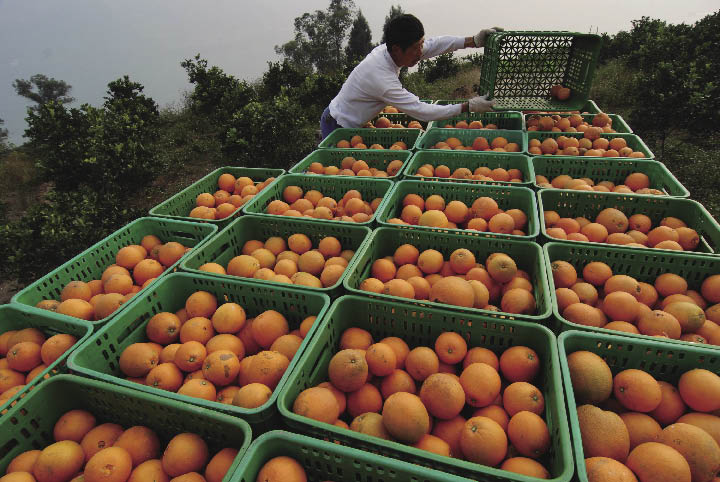| Citrus Economy: Science and Money in the Orange Grove
By staff reporter ZHANG HONG
AT the end of 2008, Zhongxian County of Chongqing Municipality produced China’s first cup of pure, undiluted citrus juice, a natural beverage free of additives and antiseptics. According to industry insiders, Zhongxian County in the Three Gorges Reservoir Area follows only Florida in the United States and Sao Paulo in Brazil to become a provider of high quality citrus juice to the world.
Peeling Off the Profits
Four years ago, Ma Heli and his wife planted orange trees on their property in Youyi Village, Zhongxian County and never looked back. His orchard of 0.27 hectares yielded 8,000 kilograms of the fruit, a harvest that netted him RMB 10,000 from the processing plant. “I also do some odd jobs. Since life has got better for us we can take things easy,” said Ma Heli.
Zhongxian County has a history of 2,300 years and is the only county in the Three Gorges Reservoir Area that has preserved the old look of its days as a county seat. It is considered the best place for citrus production in China.
 |
|
A complete citrus industrial chain has formed in the Three Gorges Reservoir Area. China Foto Press |
After investigating the tracts of surrounding land, experts concluded that the period after the large reservoir begins to retain water produces a thermal effect most suitable for citrus trees. The new varieties of seasonal oranges cultivated in Project 948 of the Ministry of Agriculture consist of Fengjie late-ripening orange, Kaixian spring orange, and tarocco blood orange (Citrus sinensis Osbeck). They have diversified the citrus crops of the reservoir area, and are fruits for which China owns independent intellectual property rights.
The impetus to grow fruit goes way back in Zhongxian County; it is the cradle of the Ba Culture and crops here traditionally included litchi and citrus. Zhu Xiyan, secretary of the CPC Zhongxian County Committee, informed us, “In the Tang Dynasty (618-907), Bai Juyi encouraged the local people to plant trees when he served as the governor of Zhongzhou Prefecture (present-day Zhong-xian County). The jurisdiction is the second largest relocated county in the Three Gorges Reservoir Area. More than a decade ago, the county authorities began to industrialize the production of oranges as various localities were busy resettling the waterside populations.
Liu Guizhong, magistrate of Zhongxian County, told China Today that the county practices standardized management of the trees. Orchard density is kept at an average of 675 trees per hectare, all nurtured by organic fertilizer. Processing policy demands the juice be pressed within 24 hours of harvesting. No additives or antiseptics are added, and the juice is canned immediately.
| 